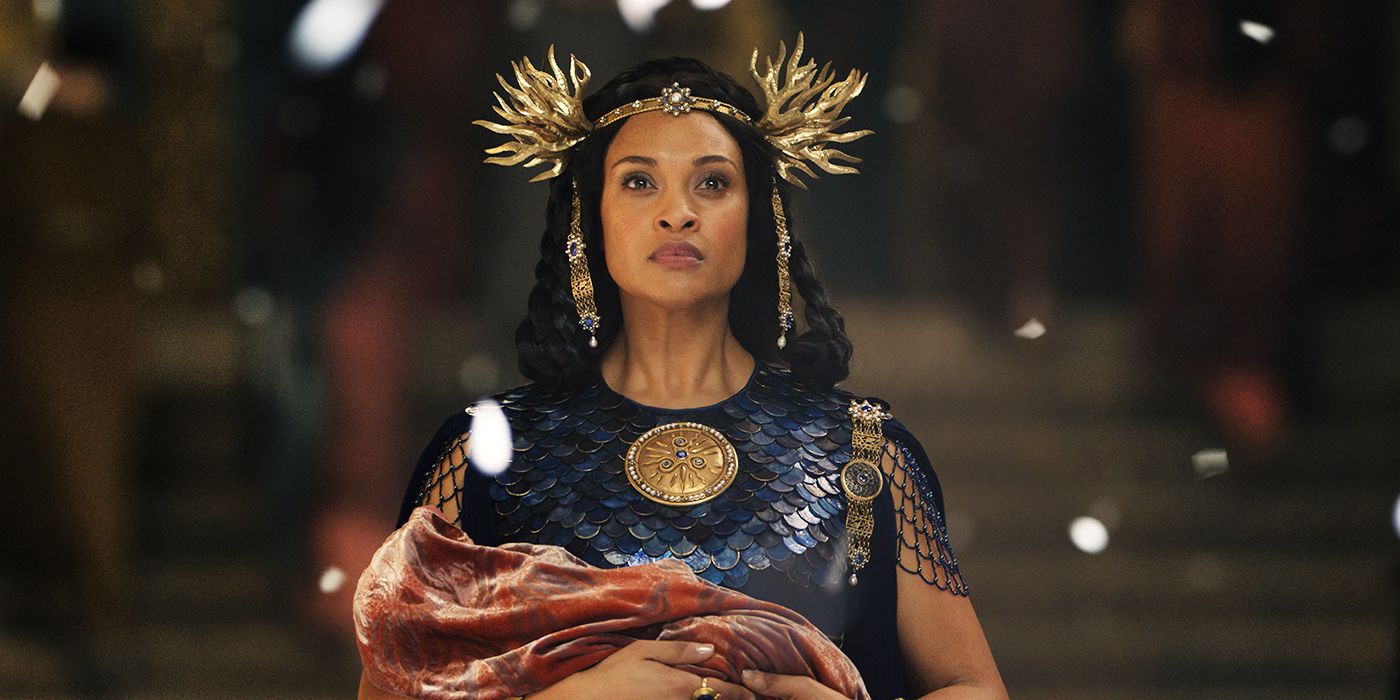Editor's Note: The following article contains spoilers for Episode 3 of The Lord of the Rings: The Rings of Power.The Lord of the Rings: The Rings of Power has made a habit out of ending on cliffhangers: in Episode 1, it was the arrival of The Stranger (Daniel Weyman); in Episode 2, it was the Dwarven box of mysteries; in the third episode, it was the arrival of the enigmatic Adar (Joseph Mawle). But one of the more curious questions hanging over Episode 3 was the distant presence of the actual king of Númenor. Despite the series of court scenes and pointed political maneuvering, the man who technically holds supreme authority in the island kingdom was nowhere to be seen. One of the final shots in the episode was of Míriel (Cynthia Addai-Robinson) climbing up the steps of a tower to confer with her father, but even then, the audience could not see or hear him. So who is he supposed to be? And why is Míriel consulting with him?
Well, if you were ever interested in reading encyclopedic lists of kings and timelines of a fictional universe, do I have a treat for you: check out Appendix B of The Lord of the Rings. All the names and dates you could possibly imagine are in there (as well as a whole bunch that you couldn’t). But one of the things that this index does help to understand is the line of the kings of Númenor, and how the island got from the rule of the awesomely-named Elros Tar-Minyatur to Míriel and beyond.
How Did Númenor Become Divided?
But what the extended writings of Tolkien offer, in addition to everything else, is that we already know at least part of the answer to the mystery of Míriel’s father, the technical king: his name is Tar Palantir, or Palantir, for short. It depends on how well you know him. His significance has a great deal to do with the historical development of Númenor as a whole, for his exile is a result of the way he stood in relation to his ancestry.
Tar Palantir is the 24th king of Númenor, and he came to that position as a result of unusual historical quirks: the first king of Númenor was Elrond’s brother, Elros Tar-Minyatur, and the succession was fairly smooth and regular until the eighteenth king, Tar-Calmacil. What happened late in Númenorean history was that the political life of the island became divided between the majority party of the “King’s Men”, who began to resent the immortality of the Elves and the restrictions placed upon them by the Valar, and the minority party, “The Faithful”, who trusted in the Valar and maintained relationships with the Elves.
What made Tar-Calmacil so significant in this regard was that he became the first Númenorean king to take a different name. All the names of the kings before him had officially been in Quenya, the language of the Elves. But Tar-Calmacil took a second name in Adunaic (a specifically Númenorean language) instead. He was known as Ar-Belzagar by the people of his time, though his name was still officially in Quenya. His successor followed suit, with the Quenya name of Tar-Ardamin and the Adunaic name of Ar-Abattârik.
Who Is Palantir, the 24th King of Númenor?
The breaking point came with the twentieth king: the son of Ar-Abattârik, Ar-Adûnakhôr. He outlawed the language of Quenya and took only an Adunaic name (though a Quenya name was secretly entered on the scroll of kings for him). This change did not bode well for the Faithful, and only got worse: the great-grandson of Ar-Adûnakhôr was Ar-Gimilzôr, who actively persecuted the Faithful and kept them under surveillance, considering them spies of the Elves because of their fidelity.
Ironically, though, it was through Ar-Gimilzôr that a ray of light finally came back to Númenor and a hope for redemption began to take root: the king married a beautiful woman named Inzilbêth who was also a descendant of Tar-Calmacil; what he found out later was that she was also a member of the Faithful. The couple ended up having two sons, the elder of whom was named Inziladûn, and the younger named Gimilkhâd. Gimilkhâd took after his father, but Inziladûn was much more like his mother, and also supported the Faithful. While Ar-Gimilzôr would have preferred to have his younger son succeed him (and Gimilkhâd’s son, Pharazon, would cause plenty of future problems), the law stipulated that the eldest son would inherit the throne, and so Inziladûn became king upon his father’s death, breaking with his immediate ancestors and returning to the ancient tradition of the Númenoreans in taking a Quenya name: Tar-Palantir.
As a result of his sympathies for the Faithful, they were no longer persecuted, and he began to revive the ancient traditions broken in preceding generations. He observed the traditional religious rites of the Númenoreans, and tended to the Tree of Númenor again, unlike his father, because of his peculiar gift. “Palantir” means “far-sighted”, and he seems to have had the gift of foresight. As a result, he came to understand a prophecy that the line of Kings would come to an end if the White Tree ever died.
Palantir's Name Is Not Actually Connected to the Palantir Seeing Stones
Despite his best efforts, however, he was unable to win over his own people. They still distrusted the Faithful and began to resent their own king because of his support for them. As a result, he was slowly forced to withdraw from his authority, retiring to the tower of Tar-Minastir in the west of his kingdom, and gradually ceding authority to his daughter, Míriel. Notably, however, while the seeing-stones known as Palantir (seen in The Lord of the Rings films) were kept by the Númenoreans at the time, Tar-Palantir did not create them; nor was he named after them. The seeing-stones, according to tradition, were made by the Elf lord Fëanor, who also created the Silmarils of the First Age. While Tar-Palantir probably used the stones in service of his prophecy, the similar name comes from a similar gift: both the stones and the man could see a great distance off, in time and space, and while Tar-Palantir failed to redeem his people, hope briefly flickered for their redemption in the rulership of his daughter Míriel.
Which leads, appropriately, to the scene at the end of Episode 3. What are Palantir and Míriel talking about? We are likely to find out eventually, but Míriel mentions the fact that something foreboding has happened: an elf has arrived on their shores. While it is unclear what this is supposed to mean, the way Míriel talks about it seems to suggest that this event is an omen predicted by the prophecies of her father: what it means to them is yet to be revealed, but considering the tone of the scene and the history of Númenor, it does not likely bode well for their future.




